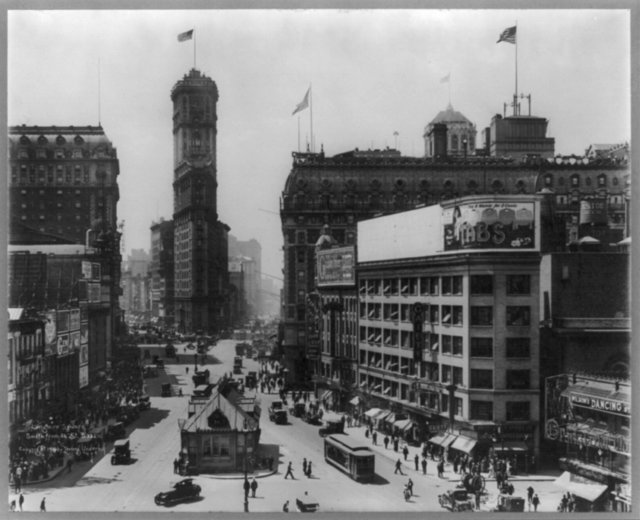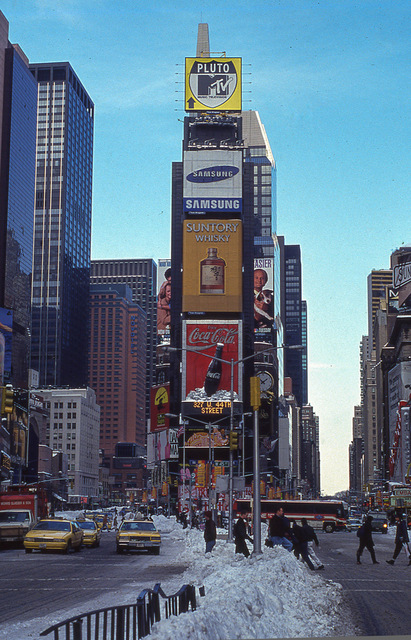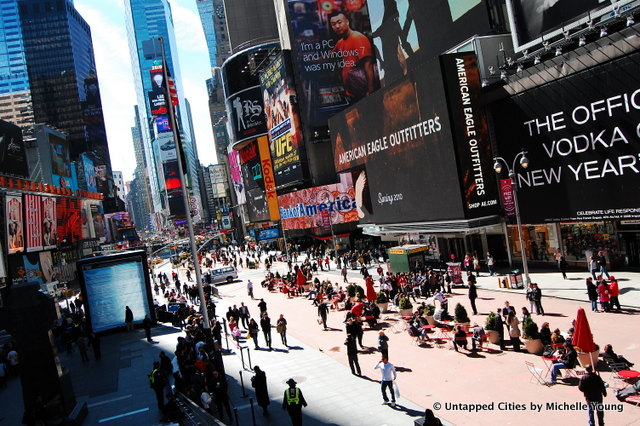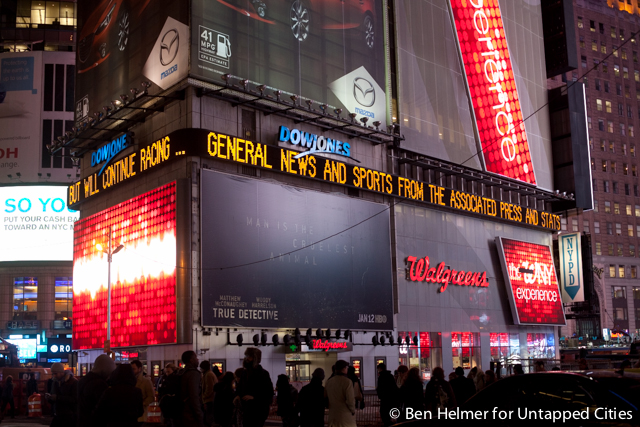The New York City subway carries many secrets, like any extensive system that was built over time. But the NYC subway also comes with it quite a bit of lore–from its urban explorers who have explored every nook of its vastness, the technological feat it was to build in some of the toughest Manhattan schist, and its evolution from high-class experiment to mass ridership.
No list of subway secrets can be complete, so we see this article as an evolving entity. We’ve started with our favorite secrets but encourage you all to comment and Tweet at us (@untappedcities) with other hidden gems. Special thanks to Matt Litwack, author of Beneath the Streets: The Hidden Relics of New York’s Subway System for contributing his finds to this piece.
1. The Many Abandoned Levels and Platforms of the NYC Subway System
 Disused platform and subway entrance at Chamber Street
Disused platform and subway entrance at Chamber Street
As the New York City subway system expanded and changed, some stations and platforms were rendered obsolete or combined into new forms. If you look closely enough, you’ll start to see the patchwork updates that close off the former structures from view. There’s the famous City Hall subway station that was decommissioned because its curved track could non longer accommodate new, longer trains. Then there’s also the abandoned platforms underneath 42nd Street A/C/E, which once accommodated the special Aqueduct Racetrack train, Nevins Street and Bergen Street in Brooklyn.
But there’s also one Chambers Street platform, deteriorating right before your eyes after its closure following the opening of the J/Z lines in 1931. Part of the station actually became the basement of the Municipal Archives. The Grand Central Terminal walkway to the shuttle has the remnants of a subway station that was never finished. Lexington Avenue-63rd Street has the remnants of a tunnel that was originally constructed for the Second Avenue Subway in the 1970s but was never completed–it’s being incorporated into the new plans. Take a look at photographs from 9 of NYC’s abandoned stations and platforms here along with 7 completely abandoned subway stations.
2. The Decommissioned City Hall Subway Station

This is the most famous of the “abandoned” subway stations, for its unique curved design and Guastavino tiling–opened as the crown jewel of the new New York City subway system in 1904. And rightly so, as it’s the only station to have so much detail: stained glass, Roman brick, tiled vaults, arches and brass chandeliers. The curvature of City Hall station platform could not accommodate the longer trains we see today without extensive renovations, so the station was decommissioned in 1945. The station was designated an interior landmark in 1979. You can see the station by becoming a member of the MTA Transit Museum. Or you can stay on the 6 train after the last stop at Brooklyn Bridge and if the old station is lighted, you can catch a glimpse of the platform. The train will then return to Brooklyn Bridge on the uptown track. More photos here.
3. Subway Entrances in the Woolworth Building

As part of the elements included in the Woolworth Building to make it irresistible to prospective tenants (just look at the cathedral-like lobby!) was the direct access to the subway. According to Woolworth Building tour guide Jason Crowley, the above red doors once led to a “passageway under Broadway to the BMT and IRT subways. The BMT is now the City Hall R stop and the IRT is the now closed off City Hall stop [above] where the 6 turns around.That passageway was completely filled in under Broadway and no longer exists.”
Join us on our next exclusive tour of the off-limits Woolworth Building on October 9th! More dates here.
4. The Underbelly Project
Underneath Williamsburg at South 4th Street there’s a 6-track station of the IND line that was never opened. In 2009, over the course of a year, street artists PAC and Workhorse invited 100 street artists in and out of the station to create work there overnight. dubbed The Underbelly Project. The idea was to create an underground gallery, but as PAC describes, apart from recruiting artists they could trust from pre-existing relationships, everything “happened organically along the way.” This video tells the story and shows the art well, and the project went on to be replicated in Paris. Whether the art still exists in the NYC subway station remains a question, but most we’ve spoken to feel that the MTA sealed off the station and it has remained relatively untouched. Second Avenue Sagas has a great explanation of the unused subway station.
5. New York Public Library at Lexington Avenue/53rd Street Subway Station
 Image via Yelp
Image via Yelp
This small New York Public Library Branch entrance is located underground in the subway station (outside the turnstile of course). It’s got everything that an aboveground NYPL has–books of course (that can be advance requested online), free Wi-Fi, outlets for your computer and helpful staff. To access, go to the 6 train downtown subway entrance on the Northeast corner of Lexington Avenue and 50th Street.
6. The Abandoned Station Rave with Wanderlust Projects
 Image via Gothamist
Image via Gothamist
The evening we spent here with Wanderlust Projects, the same group of underground events responsible for the Night Heron Speakeasy in a watertower, goes down as one of the most incredible experiences we’ve had in the New York. With impeccable coordination, 200 of us climbed down through a hatch in the midst of a busy area of New York City and entered an unused station. Lines of what would have become tracks became places to run around and explore. Staircases led to openings that looked down on a central “Echo Vault” on which performances were shortly about to take place.
Then the Extra Action Marching Band turned the whole thing into a rocking, other worldly event, which Gothamist writer John Del Signore captured perfectly as an “exorcism disguised as a dance party.” Nobody was allowed to take photos or have their cell phones on, so the only photos from the event are here. The dispersal was just as magical (apart from a slight, hilarious delay where the staff couldn’t get the hatch lock to work). We emerged from the hatch onto the city streets and left in all different directions, calmly into the night reinserting ourselves into society. We’re keeping this location mum.
7. Mass Transitscope in the Abandoned Myrtle Ave Subway Station
 A rendering of the installed art piece at the abandoned Myrtle Ave subway station. Source:MTA
A rendering of the installed art piece at the abandoned Myrtle Ave subway station. Source:MTA
This art installation by MTA Arts for Transit is one of our favorite reuses of an abandoned station. Closed in 1956, Myrtle Ave subway station used to run on the Brooklyn-Manhattan Transit line between Manhattan Bridge and DeKalb Avenue. The DeKalb Ave section ran into a lot of problems as it was the chokepoint for the entire BMT Broadway subway operation, “with a lot of merges and some routings crossing others at grade in the switches on both sides of the station,” writes Joseph Brennan. The entire area was rebuilt in 1956, and this caused Myrtle Ave to lose its southbound platform. The northbound platform still exists, but has been closed ever since. An artwork called Masstransiscope by Bill Brand is located in the abandoned Myrtle Ave station. Installed in 1980, the piece works like a giant zoetrope. The piece was restored in 2008 and 2013.
8. Knickerbocker Hotel Entrance in Times Square Subway

Resting idly beneath the noses of the 172,000 daily commuters bustling through the Times Square/42nd Street station complex, a pale white door with the word “Knickerbocker” etched on a plaque above it has more to it than meets the eye. The title refers to the famed hotel at the southeast corner of 42nd Street and Broadway, which was so popular in its heyday that it was nicknamed “The 42nd Street Club.” Such a reputation was built, literally, on an entrance that opened on the subway platform beneath the hotel that allowed patrons to frequent the lowest level of the hotel’s restaurants and bars. Long thought to be a secret, at the time it was anything but. The building has long since been the host of the Knickerbocker, but there are plans for redevelopment into a hotel. Read more about it here.
9. Alfred Beach’s Pneumatic Subway Below Reade Street Can Still Supposedly be Accessed Through a Manhole Grating in the Street
 Image via Library of Congress
Image via Library of Congress
With our obsession with New York City’s former pneumatic tube mail system, we would be remiss not to mention the first attempt at underground transit in the city by Alfred Beach. Bankrolled by Beach, the single track, single car line ran for only one block below Broadway from Warren Street to Murray Street from 1870 to 1873. It was a popular curiosity however, with 400,000 rides provided in the first year of operation. The station became part of the Rogers Peet Building and the entrance was sealed off. Rogers Peet Building burned down in 1898 but in 1912 while construction took place for the BMT Broadway subway line, remnants of the car and tunneling shield were found. They were given to Cornell University but the whereabouts are unknown today. According to Matt Litwack, subway street artist and author of Beneath the Streets: The Hidden Relics of New York’s Subway System, there are rumors that the tunnel can still be accessed below Reade Street through a manhole in the street. We have yet to fully confirm this however.
10. The Lower Abandoned Level of the F Train
According to Litwack, you can walk from 7th Avenue to Church Avenue in Brooklyn on the F train without ever seeing a platform through an entire abandoned level, which is a replica of the active tracks above it.
11. There’s a Signal Leaning Center at the 14th Street Station

You’ve probably noticed the whimsical Tom Otterness Life Underground sculptures while at the 14th Street A/C/E station, but did you notice the MTA Signal Learning School? Heralded by a traffic light that actually changes colors, the official name of the school is the Charles E. Morehouse Signals Learning Center. According to a nearby plaque, Charles “exemplified the commitment to excellence that is the trademark of maintenance of way-signals” from 1953-2002.
12. Why do the conductors point up when the train is stopped?
Pulled from this AMA on Reddit (the answers have since been deleted because the subway conductor was upset that his words were being quoted out of context and incorrectly): “We’re pointing at the conductor’s indication board, which is a zebra-striped sign. If the sign is in front of my window, it means that the entire train is on the platform. They don’t trust us to just look (see that other question about zoning out), so required procedure is to point to it at every station before we open the doors. The absolute biggest violation a conductor can make is opening the doors where there isn’t a platform. If that ever happens, the first thing supervision is going to ask you is ‘did you point to the board?’.”
Bonus: The Abandoned Train Platform Beneath the Waldorf-Astoria
Not making this list technically because it’s part of Metro-North (previously New York Central Railroad), is the secret train platform underneath the Waldorf-Astoria that supposedly brought FDR directly into the hotel. And there was allegedly an Andy Warhol party held down there. Read more about it here.
We know there are tons of other secrets, so we’ll be regularly updating this page with reader suggestions as they come! Also check out our ongoing coverage inside the Second Avenue Subway construction. Get in touch with the author @untappedmich.
 Image by Peter Dougherty via
Image by Peter Dougherty via  Image by Peter Dougherty via
Image by Peter Dougherty via  Image by Peter Dougherty via
Image by Peter Dougherty via  Image by Peter Dougherty via
Image by Peter Dougherty via  Image by Peter Dougherty via
Image by Peter Dougherty via 

 Mosaic of 6 entry boards for the Municipal Art Society competition. (Credits: William F Schacht & Cassandra Mcgowen, Richard Haas & Judith DiMaio, Gilbert Gorski, Frank Lupo & Daniel Rowen, Lee Dunnette, Jaime Gonzales-Goldstein & Martin Maurin, George Ranalli, Paul Bentel & Carol Rusche
Mosaic of 6 entry boards for the Municipal Art Society competition. (Credits: William F Schacht & Cassandra Mcgowen, Richard Haas & Judith DiMaio, Gilbert Gorski, Frank Lupo & Daniel Rowen, Lee Dunnette, Jaime Gonzales-Goldstein & Martin Maurin, George Ranalli, Paul Bentel & Carol Rusche
 William Sloan
William Sloan David Suter
David Suter Frank Lupo and Daniel Rowen with Karen Maloof
Frank Lupo and Daniel Rowen with Karen Maloof George Ranalli
George Ranalli Jaime Gonzales-Goldstein and Martin Maurin
Jaime Gonzales-Goldstein and Martin Maurin Lee Dunnette
Lee Dunnette Paul Bentel and Carol Rusche
Paul Bentel and Carol Rusche
 Taeg Nishimoto
Taeg Nishimoto William Schact and Cassandra McGowen
William Schact and Cassandra McGowen

 Image via
Image via 













 Times Square, then Long Acre Square in 1905
Times Square, then Long Acre Square in 1905 c. 1903
c. 1903 Times Building, c. 1906
Times Building, c. 1906 Times Square, 1905
Times Square, 1905 Hotel Astor c. 1915-1920
Hotel Astor c. 1915-1920 Hotel Knickerbocker in Times Square, c. 1909
Hotel Knickerbocker in Times Square, c. 1909 New York Theatre, 1900-1915
New York Theatre, 1900-1915 View looking up Broadway from 39th Street to the Times Building and the Hotel Astor, c. 1903-1910
View looking up Broadway from 39th Street to the Times Building and the Hotel Astor, c. 1903-1910 View from the Times Building, 1911 including row of motorized taxis
View from the Times Building, 1911 including row of motorized taxis Cast-iron subway entrance at the foot of the Times Building, part of the initial rollout of the IRT subway line (c. 1904-1910)
Cast-iron subway entrance at the foot of the Times Building, part of the initial rollout of the IRT subway line (c. 1904-1910) 1908, crowds gather for a film screening on the Times Building
1908, crowds gather for a film screening on the Times Building Advertising in Times Square, c. 1904-1915
Advertising in Times Square, c. 1904-1915 In 1919, a large crowd gathered outside the Times Square to get the results of the World Series from a remote scoreboard
In 1919, a large crowd gathered outside the Times Square to get the results of the World Series from a remote scoreboard Times Square, c. 1919. Note above ground fare control station.
Times Square, c. 1919. Note above ground fare control station.
 1943
1943 A color photograph of Times Square in 1944
A color photograph of Times Square in 1944 Crowd of people on V-J Day in 1945, after the Japanese surrender
Crowd of people on V-J Day in 1945, after the Japanese surrender In 1961, actresses Millette Alexander and Louise King, and nightclub entertainer Ted Lewis, stand outside a giant mailbox stamp selling booth in Times Square, New York City, while Assistant Postmaster Aquiline F. Weierich dispenses stamps from inside the booth. Camel advertisement, with a football player, is seen in the background.
In 1961, actresses Millette Alexander and Louise King, and nightclub entertainer Ted Lewis, stand outside a giant mailbox stamp selling booth in Times Square, New York City, while Assistant Postmaster Aquiline F. Weierich dispenses stamps from inside the booth. Camel advertisement, with a football player, is seen in the background. Source via Flickrriver
Source via Flickrriver Gay Liberation Front marches on Times Square in 1969 Source: Diane Davies/NYPL Manuscripts and Archives Division
Gay Liberation Front marches on Times Square in 1969 Source: Diane Davies/NYPL Manuscripts and Archives Division 1993-1998, photo by
1993-1998, photo by 
 42nd Street Destruction, 1997
42nd Street Destruction, 1997

 Rendering via Times Square Alliance
Rendering via Times Square Alliance Image via Wikimedia by
Image via Wikimedia by 


 Image via
Image via 


 The
The  “A Year on Broadway: Times Square, 45th to 46th Street, December 17, 2014″ Image via
“A Year on Broadway: Times Square, 45th to 46th Street, December 17, 2014″ Image via  Image via
Image via  NYC’s Flatiron Building on Île de la Cité with the Pont Neuf in Paris
NYC’s Flatiron Building on Île de la Cité with the Pont Neuf in Paris
